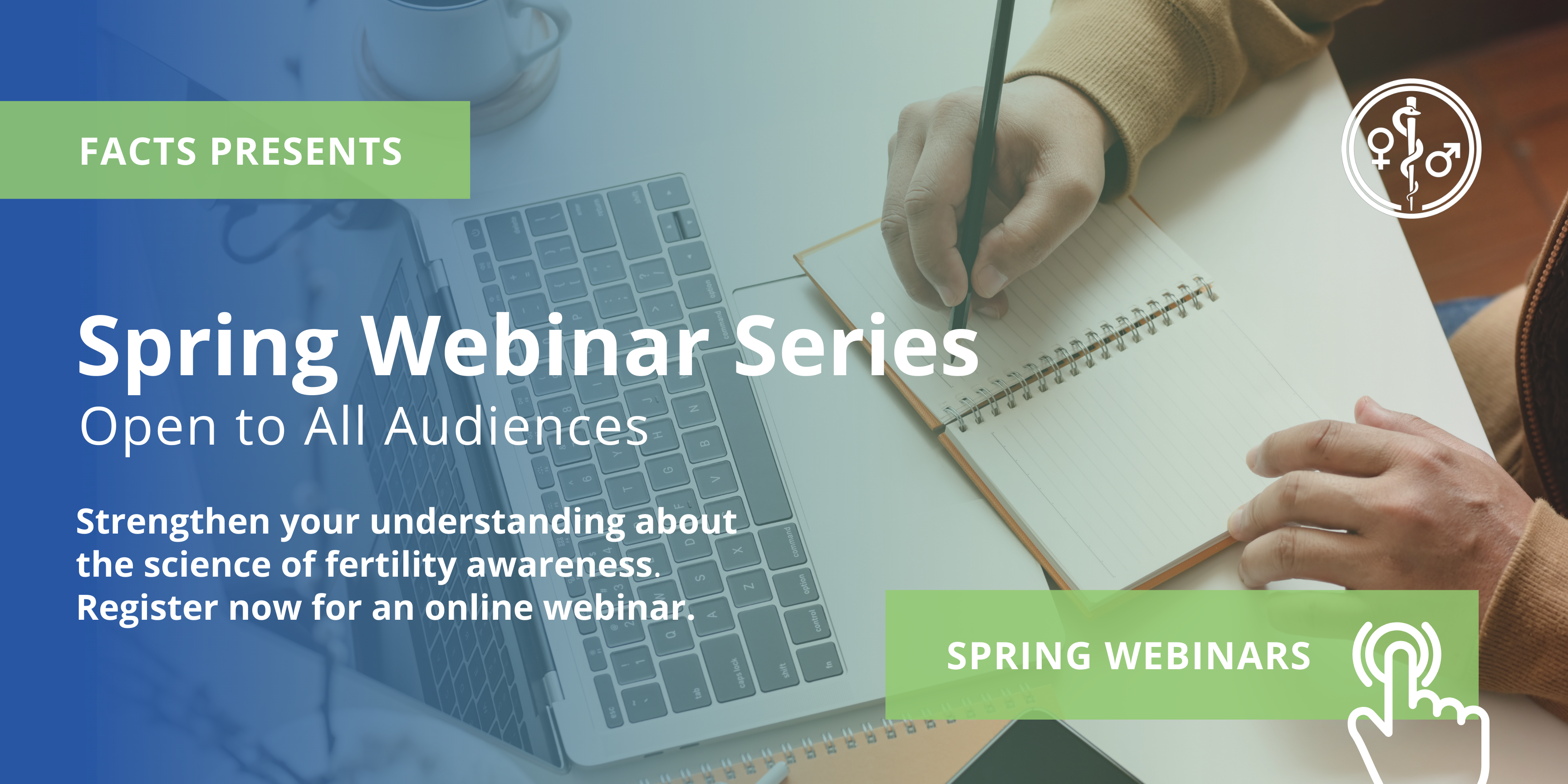Editor’s Note: It is essential to understand and respect several aspects of fertility awareness-based methods (FABMs) in order to maximize their effectiveness. These vital elements include the need to learn how to use each method from a trained instructor and to follow the rules and/or guidelines of each method consistently when using it for family planning. A fourth-year medical student on the FACTS elective interviewed a friend, and their conversation highlights both of these important aspects of using these methods.
Introduction
Maggie* is a friend of mine. We attended college together at a Catholic university, which is where she learned the most about fertility awareness. She had heard about FABMs in high school but started to gather more information when she joined a women’s group on campus. Recently, we had a phone conversation to talk about her experiences with FABMs.
Learning about Biomarkers
Maggie started noticing and tracking biomarkers in herself about three years ago. She was motivated mainly by a desire to know when her period would start each month. After some online research, she began tracking her basal body temperature (BBT) alone, feeling as though she lacked a good understanding of cervical fluid. BBT is your temperature when you first wake up in the morning, before getting up and moving around. It increases after ovulation and remains elevated until just before your next period. Maggie learned to notice her temperature spike and found that she would reliably start her period the day her BBT came back down. She continued using this biomarker alone for a while, but eventually started to pay attention to cervical fluid as well.
Given that her main motivation was simply to predict her period rather than family planning or health monitoring, these ad hoc observations served the intended purpose without the need for more rigorous training. Throughout this time, she logged her observations in the Kindara app, which marks the time when a temperature is recorded. Maggie’s lifestyle didn’t lend itself well to waking up at the same time every day, so it was useful to know which temperatures might be off (i.e., not a true measure of BBT) because of timing. She noticed that when she took her temperature a few hours later in the day, the later measurements were always higher. This is why, when using an FABM for family planning, it is necessary to take one’s temperature the correct way at the same time every day.

Learning the Sympto-Thermal Method
Some months later, Maggie started learning a specific system for family planning in preparation for marriage. At the recommendation of friends, she and her fiancé took classes with the Couple-to-Couple League (CCL) to learn the Sympto-Thermal Method (STM). This was her first time attempting to determine her fertile window. Although she did not enjoy the classes, she likes having the textbook as an additional resource. Maggie started logging her observations both in the Kindara app and in the CCL app, Cycle-Pro-Go.
Unfortunately, after a few months of charting, she realized the Sympto-Thermal Method would not work for her. Based on her observations and their formula, she had not logged a single day in the previous three months that was not “potentially fertile.” She acknowledges she did not take her temperature at the same time every day, so she was not using the method correctly. Still, based on her cervical fluid observations alone, the system seemed to indicate she was potentially fertile all the time. Seeking answers and support, she showed her charts to instructors, who noted the charts looked correct, and she was potentially fertile all those days. This seemed unlikely to be true, so the couple decided to try a different method. They plan to start classes to learn the Creighton Model and hope the increased level of individualized instruction will help her identify her true fertile window.
Something for Everyone
An important lesson from Maggie’s experience is that different FABMs will work for different women at different points in their lives. It is okay to try a method, realize it does not work for you, and then try something else. Thankfully, as we learned during the FACTS elective, there are many options available using a variety of biomarkers and approaches to suit different needs. Some methods use cervical fluid alone (Creighton, Billings, Two-Day), temperature and cervical fluid (CCL, Sensiplan, SymptoPro), cervical fluid and urinary hormones (Marquette), and more.
Maggie knew that if she wanted to use FABMs for family planning, she needed to learn from trained instructors and follow a specific method rather than teaching herself or piecing together her own method.
This is important because the data on the efficacy of these methods to avoid pregnancy are only valid for couples who learned from trained instructors and follow the rules of one chosen method, rather than trying to mix and match.
Despite the hiccups she encountered with the STM, Maggie remains dedicated to using a fertility awareness-based method for family planning. While she is glad her faith tradition supports it, her main reason for choosing fertility awareness is a preference to avoid hormonal medications and medical devices. When possible, she prefers natural methods over medications to address her health needs. She views medications as necessary at times but prefers to use them as a last resort. This goes to show that women use FABMs for a variety of reasons. As medical professionals, it is important to equip ourselves with the knowledge to talk about these methods with patients and to support and empower women who use them, whatever their motivation.
Editor’s Note: Although this story is not the typical experience of most FABMs users, it is Maggie’s story. It is quite possible that, by using a cervical fluid method such as the Creighton Model, she may have identified a continuous cervical mucus pattern, and her physician and trained instructors could then support her through that. Her perseverance in choosing to learn a new method will likely lead this couple to an FABM that works for them. Follow the link to read about a couple that has had 25 years of success with the Sympto-Thermal Method.
*The patient’s name was changed to protect privacy.
ABOUT THE AUTHOR
This interview was conducted by a fourth-year medical student while on the FACTS elective. She plans to specialize in family medicine. She is excited to learn more about fertility awareness-based methods, help share the science behind them with others, and use her knowledge about FABMs to serve her patients throughout her career.
Inspired by what you read?
You can support the ongoing work of FACTS here. To connect with a member of our team, please email development@FACTSaboutFertility.org. Interested in becoming an individual or organizational member? You can learn more and register here. To discuss with a member of our team, please email membership@FACTSaboutFertility.org.






